
The Brussels Stock Exchange, abbreviated to BSE, was founded in Brussels, Belgium, by decree of Napoleon in 1801. In 2002, the BSE merged with the Amsterdam, Lisbon and Paris stock exchanges into Euronext, renaming the BSE Euronext Brussels. The most well known stock market index on the BSE is the BEL20.
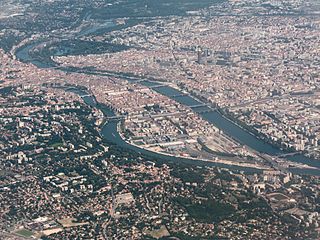
The Presqu'île is the central part of the City of Lyon, France. Extending from the foot of the Croix-Rousse hill in the north to the confluence of the Rhône and the Saône rivers in the south, it has a preponderance of cafés, restaurants, luxury shops, department stores, banks, government buildings and cultural institutions.
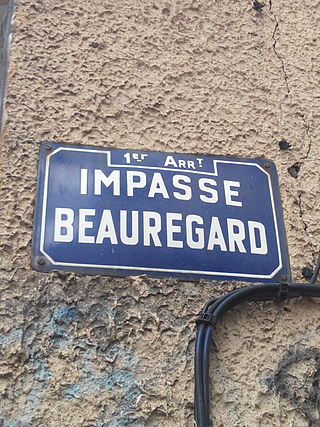
The 1st arrondissement of Lyon is one of the nine arrondissements of the City of Lyon. It is located below the hill of Croix-Rousse and on the north part of the Presqu'île formed by the Saône and the Rhône, the two rivers in Lyon.
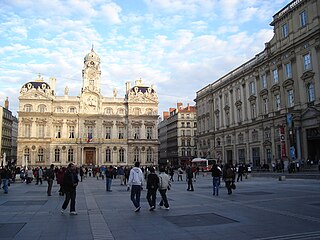
The Place des Terreaux is a square located in the centre of Lyon, France, on the Presqu'île between the Rhône and the Saône rivers, at the foot of the hill of La Croix-Rousse in the 1st arrondissement. It borders both the Hôtel de Ville and Musée des Beaux-Arts de Lyon. The square belongs to the zone classified as a World Heritage Site by UNESCO.
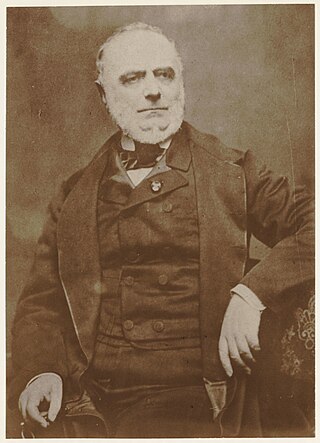
Claude-Marius Vaïsse was a French lawyer who joined the administration of the July Monarchy. During the French Second Republic he was briefly Minister of the Interior. Under the Second French Empire he was appointed prefect of the Rhône department. He was called the "Hausmann of Lyon" for his work on urban design in Lyon.

The 2nd arrondissement of Lyon is one of the nine arrondissements of the City of Lyon.

The Rue de la République is a street located in the 1st and 2nd arrondissements of Lyon, France. It links the Place de la Comédie in the north to the Place Le Viste in the south, just next to the Place Bellecour, via the Place de la République.
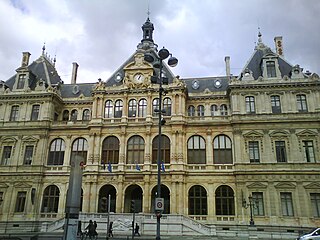
Les Cordeliers is one of the central quarters in the 2nd arrondissement of Lyon, France. It is mainly known for the Place des Cordeliers in its centre. Around the square, there are many notable monuments, including the Église Saint-Bonaventure and the Palais de la Bourse.
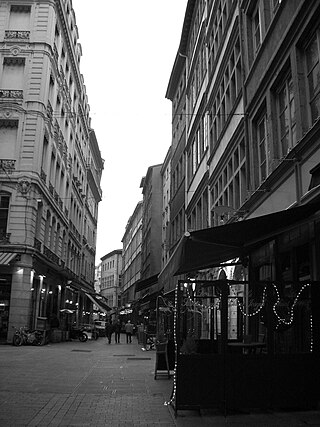
The Rue Mercière is a street of Les Cordeliers quarter in the 2nd arrondissement of Lyon. From north to south, it connects the Place des Jacobins to the Place d'Albon. This street is served by metro stations Bellecour and Cordeliers of the line and by the bus station Jacobins of the lines 91 and 99. It belongs to the zone classified as World Heritage Site by UNESCO.

The Place de la République is a square located in the Bellecour quarter in the 2nd arrondissement of Lyon, France. It is crossed by the Rue de la République along a north-south axis. It belongs to the zone classified as World Heritage Site by UNESCO.

The Église Saint-Bonaventure is one of the churches of the quarter Presqu'île, located on the Place des Cordeliers, in the 2nd arrondissement of Lyon. This is the only medieval building not demolished after the creation of the rue Impériale, under the Second Empire by the prefect Claude-Marius Vaïsse.
The Chambre de commerce et d'industrie de Lyon is one of the Chambers of Commerce and Industry of the Rhône department in France. Its headquarters is located in Lyon at the Palais de la Bourse.
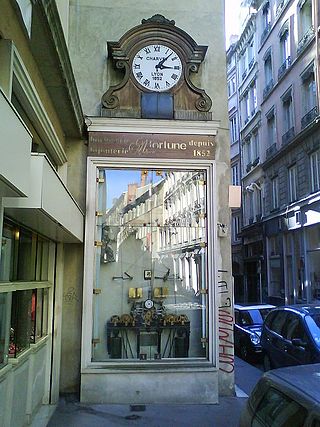
The Rue de la Poulaillerie is a street located in the 2nd arrondissement of Lyon, France. It was first named Rue Vaudran, and also Rue Maudite in reference to Peter Waldo, who founded what was considered a heresy at the time, the street received its current name from the fact that people exchanged poultry until 1835, when part of this trade emigrated to the covered market of La Martinière.
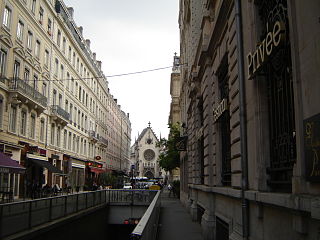
The Rue de la Bourse is a street located mainly in the 2nd arrondissement of Lyon, and also in the 1st arrondissement. It starts on the Place des Cordeliers, in the 2nd arrondissement, in front of the Église Saint-Bonaventure, and ends at right angles to the Rue du Bât-d'Argent, beyond which it is extended by the Rue du Garet.

The Rue Édouard-Herriot is one of the most important shopping streets of the Presqu'île in Lyon. It links the two most famous places of the city, the Place Bellecour (south) and the Place des Terreaux (north). Its northern part is located in the 1st arrondissement of Lyon, but the main part of the street is in the 2nd arrondissement. In its southern part, the street passes through the Place des Jacobins. It belongs to the zone classified as World Heritage Site by UNESCO.

The Rue Lanterne is one of the oldest streets of Lyon, created in the Middle Ages, which is located in the 1st arrondissement of Lyon. It begins after the Rue d'Algérie and ends against a facade of the Rue Longue.

The Rue de l'Arbre-Sec is an old street located in the 1st arrondissement of Lyon, near the Place des Terreaux and the Opera Nouvel. It starts perpendicular to the Rue Édouard-Herriot and ends with the Quai Jean Moulin crossing the Rue de la République. The name dates from the 14th century and was probably chosen because of a dry tree that could be seen in this street and of an inn sign.

The Great Synagogue in Lyon is an Orthodox Jewish congregation and synagogue located at 13 quai Tilsitt in the IIe arrondissement of Lyon, France. Designed by Abraham Hirsch in the Byzantine Revival style, the synagogue was built between 1863 and 1864 and renovated in 2014. The building was listed as a monument historique on 5 December 1984. The congregation worships in the Ashkenazi rite.

André-César Vermare was a French sculptor, known for his war memorials and monuments.

The Tribunal de commerce de Paris, until 1968 Tribunal de commerce de la Seine, refers both to the tribunal de commerce of Paris, a commercial court, and to the building that hosts it on the Île de la Cité in Paris. Because that building's main entrance is on the quai de la Corse, the phrase Quai de la Corse is used as a nickname for the court, not least with reference to its role in corporate insolvencies.


























